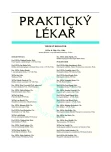-
Medical journals
- Career
Basics of social cognitive and affective neuroscience;
I. Introduction
Authors: F. Koukolík
Authors‘ workplace: Primář: MUDr. František Koukolík DrSc ; Oddělení patologie a molekulární medicíny ; Národní referenční laboratoř prionových chorob ; Fakultní Thomayerova nemocnice s poliklinikou, Praha
Published in: Prakt. Lék. 2010; 90(12): 695-700
Category: Editorial
Overview
Social cognitive and affective neuroscience (SCAN) has been developing for about 20 years. Cognitive science is considered the starting point of SCAN. The advancement of SCAN was brought about by functional imaging methods, which have a lot of limits stemming from the problem of atlas concordance. SCAN conceptualizes the functional anatomy of the brain as a set of so-called conectoms, large-scale neuronal networks. SCAN is concerned with social perception, inference and interactions.
Neuroeconomics,
neuropolitics,
neurosthetics,
moral and legal decisions
are parts of this framework. A lot of current research has been centred on the development of infants and adolescents, aging and gender differences. Cultural and comparative neuroscience is an emerging field.Key words:
social cognitive and affective neuroscience, connectome, social perception, social inference, social interaction
Sources
1. Apperly, I.A. Beyond Simulation-Theory and Theory-Theory: Why social cognitive neuroscience should use its own concepts to study „Theory of Mind“. Cognition 2008, 107, p. 266–283.
2. Bohland, J., Bokil, H., Allen, C.B. et al. The brain atlas concordance problem: quantitative comparison of anatomical parcellations. PLoS ONE 4(9), 2009, e7200. doi:10.1371/journal.pone.0007200. Interaktivní webová adresa http://obart.info - to je stránka jewelry industry information
3. Brett, M., Johnsrude, I.S., Owen, A.M. The problem of functional localization in the human brain. Nature Reviews Neuroscience 2002, 3, p. 243-249.
4. Brothers, L. The social brain: a project for integrating primate behavior and neurophysiology in a new domain. Concepts Neurosci. 1990,1, p. 27-51.
5. Dowding, P.E., Chan, A.W-Y., Peelen, M.V. et al. Domain specificity in visual cortex. Cerebral cortex 2006,16, p. 1453-1461.
6. Gazzaniga, M.S. The cognitive neurosciences III. Cambridge: The MIT Press, 2004.
7. Gong, G., He, Y., Concha, L. et al. Mapping anatomical connectivity patterns of human cerebral cortex using in vivo diffusion tensor imaging tractography. Cerebral cortex 2009, 19, p. 524-536.
8. Haidt, J.. Kesebir, S. Morality. In: Fiske ST, Gilbert D. (Eds.) The handbook of social psychology. 5th ed. New York: Wiley and Sons 2010.
9. Hein, G., Singer, T. I fell how do you fell but not allways: the empathic brain. Curr. Opin. Neurobiol. 2008, 18, p. 1-6.
10. Koukolík, F. Sociální mozek. Praha: Karolinum, 2006.
11. Koukolík, F. Před úsvitem, po ránu. Eseje o dětech a rodičích. Praha: Karolinum, 2006.
12. Koukolík, F. Lidství. Neuronální koreláty. Praha: Galén, 2010.
13. Koukolík, F. Funkční systémy lidského mozku. Praha: Galén, 2011 (v tisku).
14. Mesulam, M-M. Defining neurocognitive networks in the BOLD new world of computed connectivity. Neuron 2009, 62, p. 1-3.
15. Panksepp, J. Affective neuroscience: the foundations of human and animal emotions (Series in Affective Science). New York: Oxford University Press, 1998.
16. Palmeri, T.J., Gauthier, I. Visual object understanding. Nat. Rev. Neurosci. 2004, 5, p. 291-303.
17. Peelen, M.V., Downing, P.E. Selectivity for the human body in the fusiform gyrus. J. Neurophysiol. 2005, 93, p. 603-608.
18. Richerson, P.J., Boyd, R. Not by genes alone: How culture transformed human evolution. Chicago: University of Chicago Press, 2005.
19. Sanfey, A.G., Loewenstein, G., McClure, S.M. et al. Neuroeconomics: Cross-currents in research on decision-making. Trends Cogn. Sci. 2006, 10, p. 108-116.
20. Spezio, M.L., Rangel, A., Alvarez, R.M. et al. A neural basis for the effect of candidate apperarance on selection outcomes. SCAN 2008, 3, p. 344-352.
21. Sporns, O., Tononi, G., Kotter, R. The human connectome: a structural description of the human brain. PLoS Comput. Biol. 1, e42, 2005.
22. Strogatz, S.H. Exploring complex networks. Nature 2001, 410, p. 268-276.
23. Talairach, J., Tournoux, P. Co-planar stereotaxic atlas of the human brain. New York: Thieme 1988.
24. Thagard, P. Cognitive Science. The Stanford encyclopedia of philosophy (Fall 2008 Edition), Edward N. Zalta (ed.). Dostupné na http://plato.stanford.edu/archives/fall2008/entries/cognitive-science/.
25. Weber, S., Habel, U., Amunts, K. et al. Structural brain abnormalities in psychopaths. Behav. Sci. Law 2008, 26, p. 7-28.
Labels
General practitioner for children and adolescents General practitioner for adults
Article was published inGeneral Practitioner

2010 Issue 12-
All articles in this issue
-
Basics of social cognitive and affective neuroscience;
I. Introduction - Current opinion on urogenital tuberculosis
- Regional differentiation of the age structure of practitioners in the Czech Republic at the beginning of the 21st century
- Prevention and therapy of organovascular arterial ischaemic disease
- The impact of yoga on risk factors of cardiovascular diseases
- Doping in sport and acupuncture
-
Místo a význam institutu „dříve projevených přání“ v péči o pacienta
Interpretace a okolnosti porozumění textu - Compliance with rehabilitation programs in secondary prevention of coronary artery disease
- Patient friendly health care for migrants
- Expectations for the 2010-2011 flu
- Addictive diseases and poverty
-
Basics of social cognitive and affective neuroscience;
- General Practitioner
- Journal archive
- Current issue
- Online only
- About the journal
Most read in this issue-
Basics of social cognitive and affective neuroscience;
I. Introduction - Regional differentiation of the age structure of practitioners in the Czech Republic at the beginning of the 21st century
- Patient friendly health care for migrants
- The impact of yoga on risk factors of cardiovascular diseases
Login#ADS_BOTTOM_SCRIPTS#Forgotten passwordEnter the email address that you registered with. We will send you instructions on how to set a new password.
- Career

